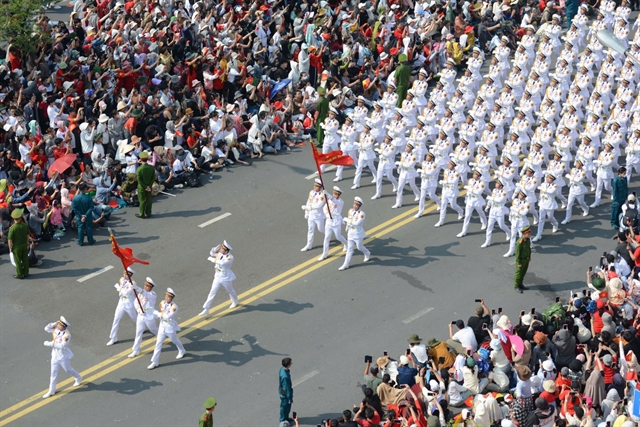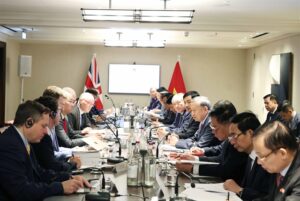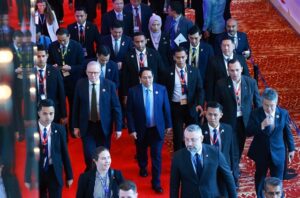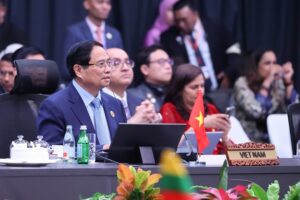Vietnam Marks 50 Years of Reunification with Grand Parade in Hồ Chí Minh City

Hồ Chí Minh City, The Gulf Observer: A magnificent military parade and civilian procession unfolded along Lê Duẩn Boulevard in District 1 on Tuesday to commemorate the 50th anniversary of the Liberation of the South and National Reunification (April 30, 1975 – April 30, 2025). The event brought together over 13,000 participants, showcasing Vietnam’s military might, national unity, and unwavering spirit.
Following solemn state-level ceremonial proceedings, the event commenced with a dramatic fly-past by Mi-8T, Mi-17, and Mi-171 helicopters, proudly bearing the Communist Party flag and the national flag. Fighter jets, including Su-30MK2 and Yak-130 aircraft, thrilled onlookers with aerial manoeuvres and dazzling flare deployments, symbolizing the strength and readiness of the Việt Nam People’s Army.
The symbolic vehicle procession began with models showcasing the National Emblem, a portrait of President Hồ Chí Minh, and a creative installation celebrating five decades of reunification. The Emblem was mounted atop a stylized Lạc bird in mid-flight, carried alongside 54 students representing Vietnam’s 54 ethnic groups, emphasizing the nation’s enduring unity.
Marching in unison were flags of the Party and the nation, representing the ideals of revolutionary struggle and continued national development. The vehicle honoring President Hồ Chí Minh was accompanied by 50 exemplary youth and children, paying tribute to the father of modern Vietnam and the architect of its liberation.
The military formations featured diverse branches of the armed forces: Ground Forces, Navy, Air Defence, Border Guards, Coast Guard, Logistics, Signals, Medical, Electronic and Cyber Warfare, Peacekeeping, and Special Forces. Each group marched in disciplined formations, highlighting their distinct missions in national defence and their evolving capabilities in the modern era.
A standout highlight was the participation of international military contingents from China, Laos, and Cambodia, underscoring Vietnam’s defence diplomacy and deep-rooted international solidarity forged during historic struggles.
Civilian military forces also took part, including Maritime Militias, Female Southern Guerrilla Fighters, Northern Militia Women, and People’s Public Security Forces. Units representing national police, air patrol, fire and rescue, and special task forces marched with pride and professionalism.
One of the most poignant moments came with the Honour Formation of Heroes of the People’s Armed Forces, Labour Heroes, and historical witnesses aboard seven decorated double-decker buses. The buses bore the names of provinces and centrally-run cities, symbolizing national unity and the nation’s deep gratitude to its heroes. This was the only formation permitted to remain seated while passing the grandstand, earning a warm and respectful welcome.
Following the military showcase, civic groups joined the parade, representing diverse sectors such as the Việt Nam Fatherland Front, veterans, former youth volunteers, workers, farmers, intellectuals, entrepreneurs, overseas Vietnamese, women’s associations, youth and children’s groups, and the cultural, sports, and media sectors.
The closing formation—comprising renowned artists, athletes, models, and beauty queens—embodied Vietnam’s modern vibrancy and cultural pride.
The ceremony concluded with a moving release of balloons and doves, symbols of peace, faith, and hope for the future—a fitting tribute to a nation that has overcome great adversity and continues to build a unified, prosperous, and peaceful homeland.
This golden jubilee celebration reaffirmed Vietnam’s journey from division to unity, from war to peace, and from struggle to progress—honouring the sacrifices of generations past while embracing a future of national dignity and pride.


